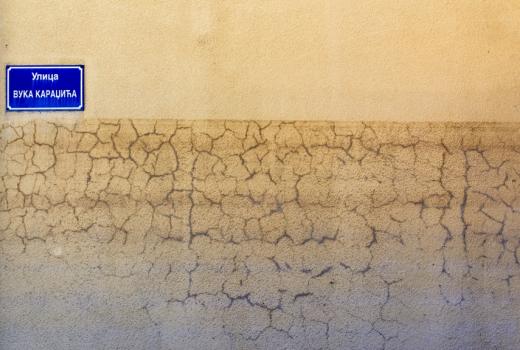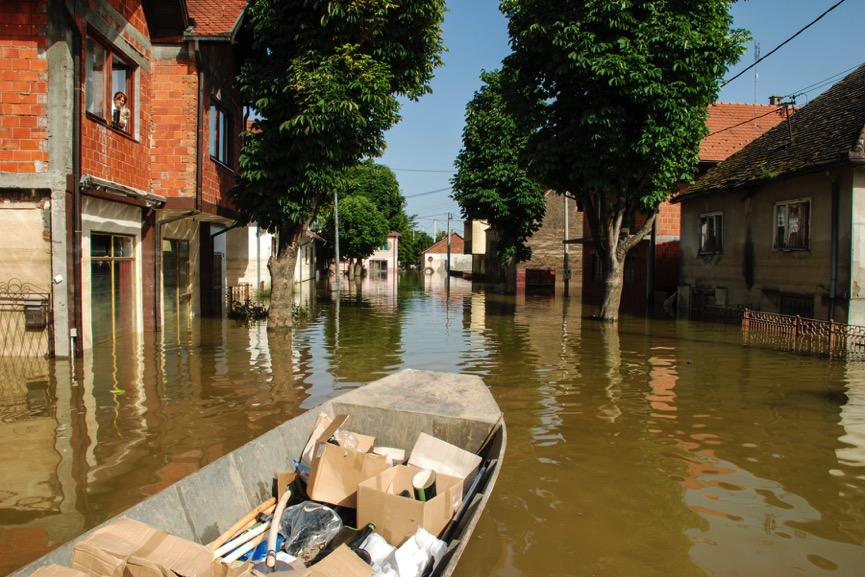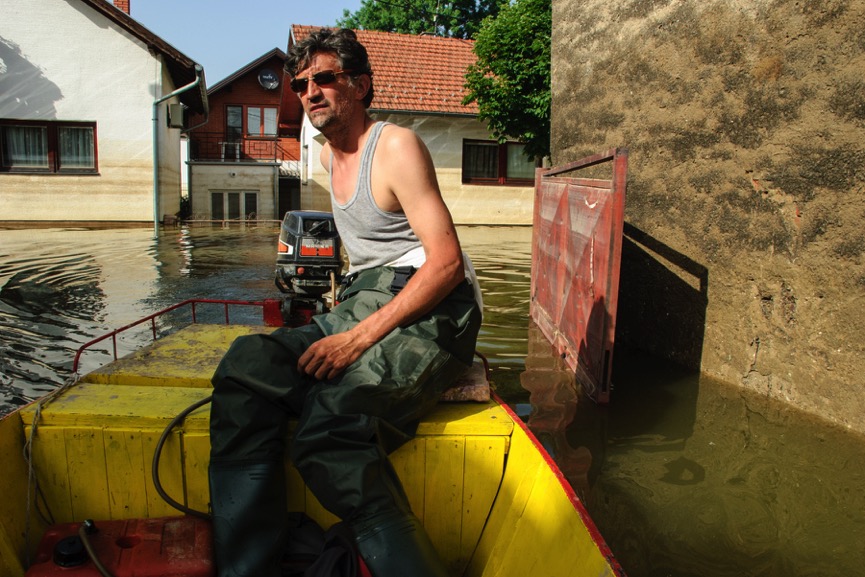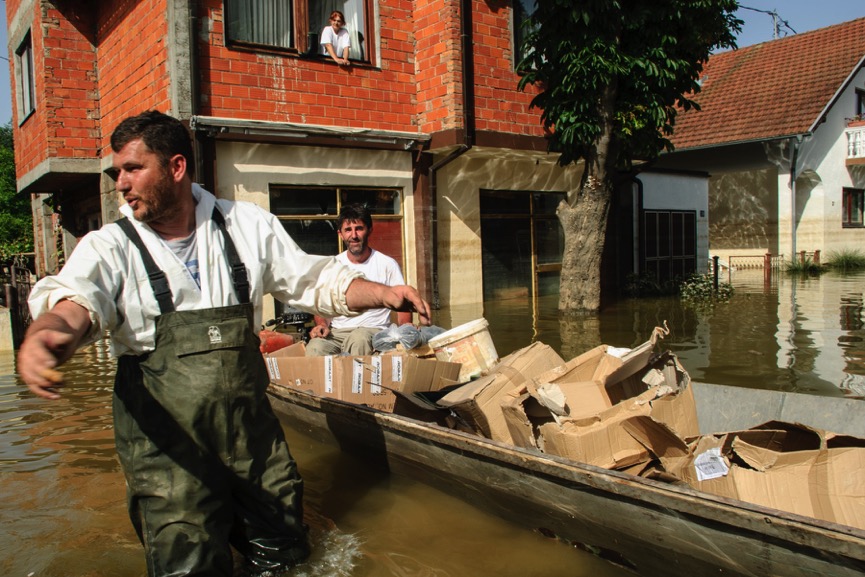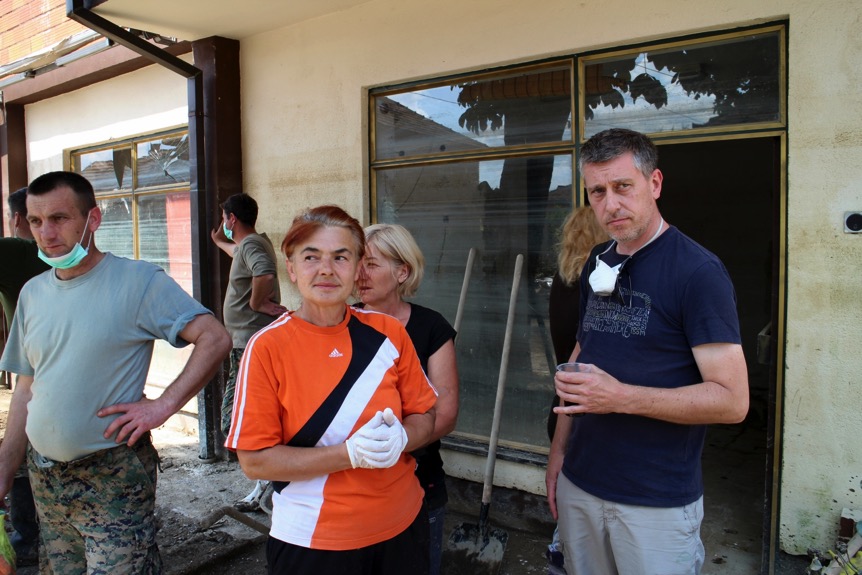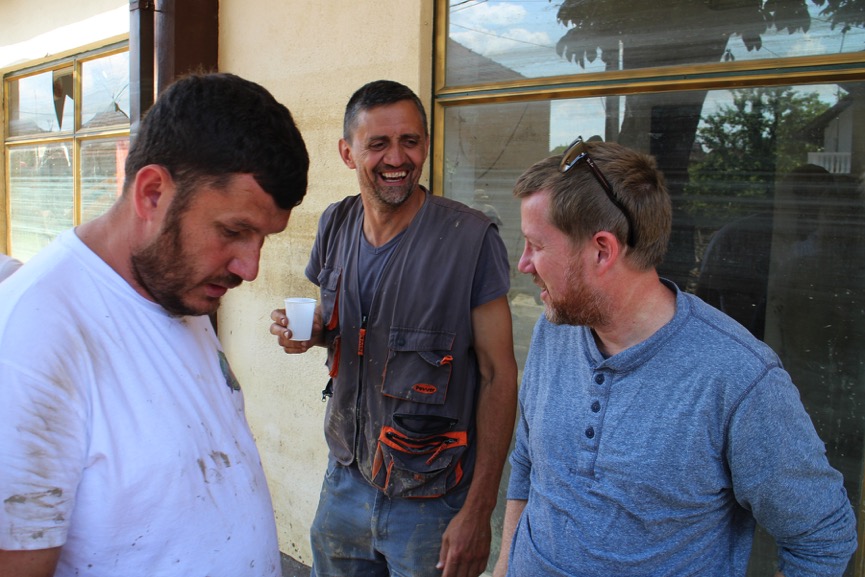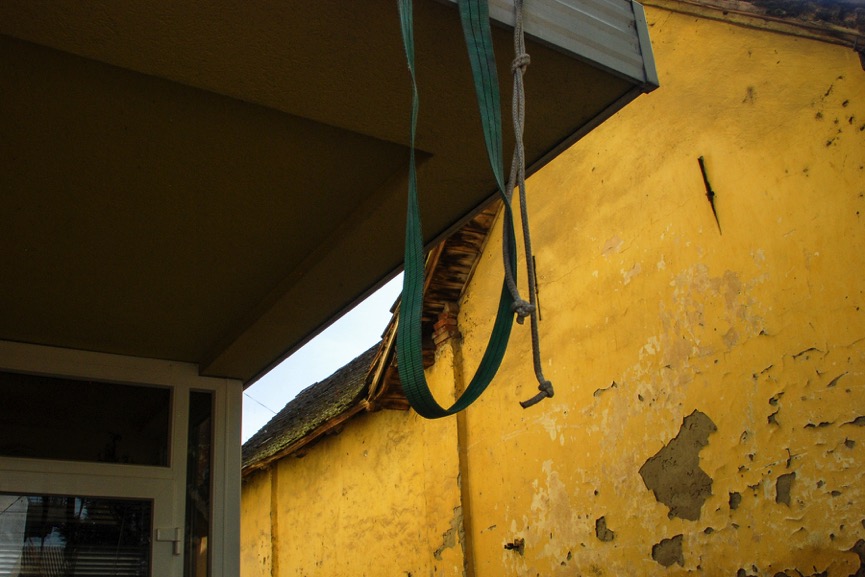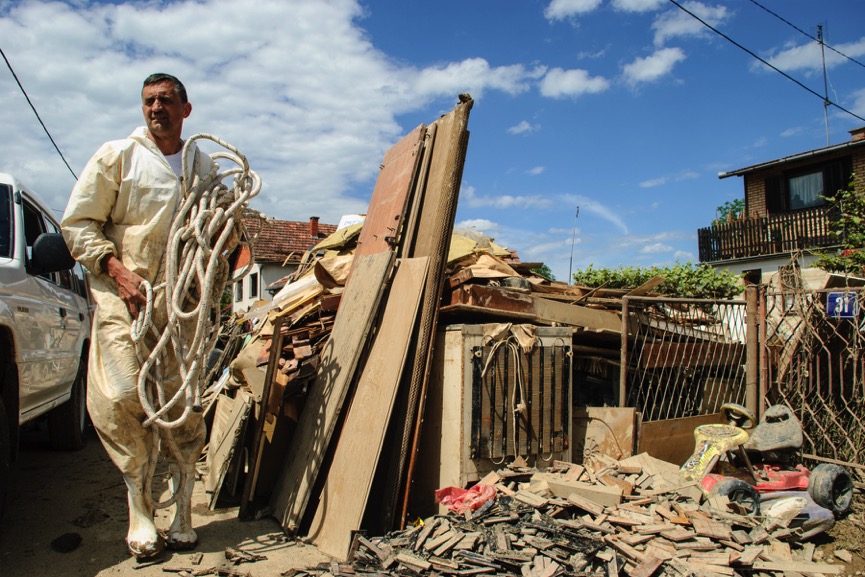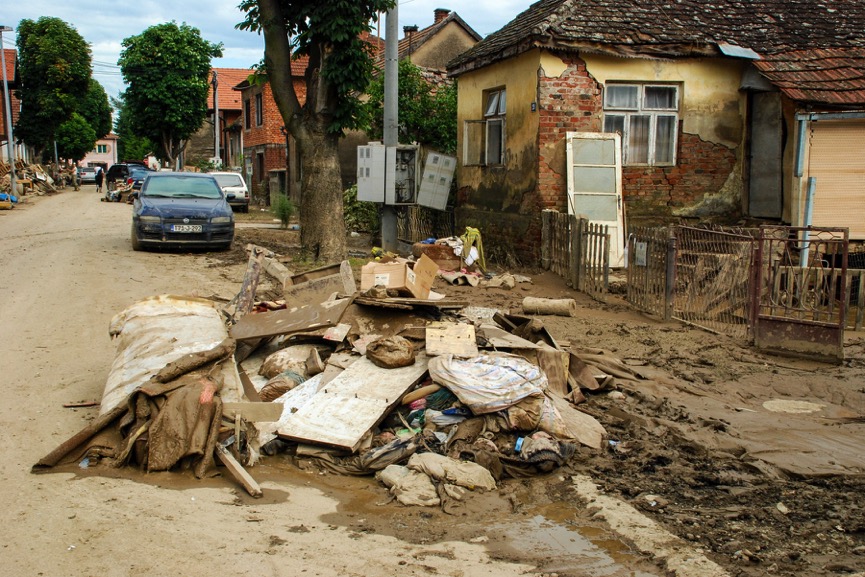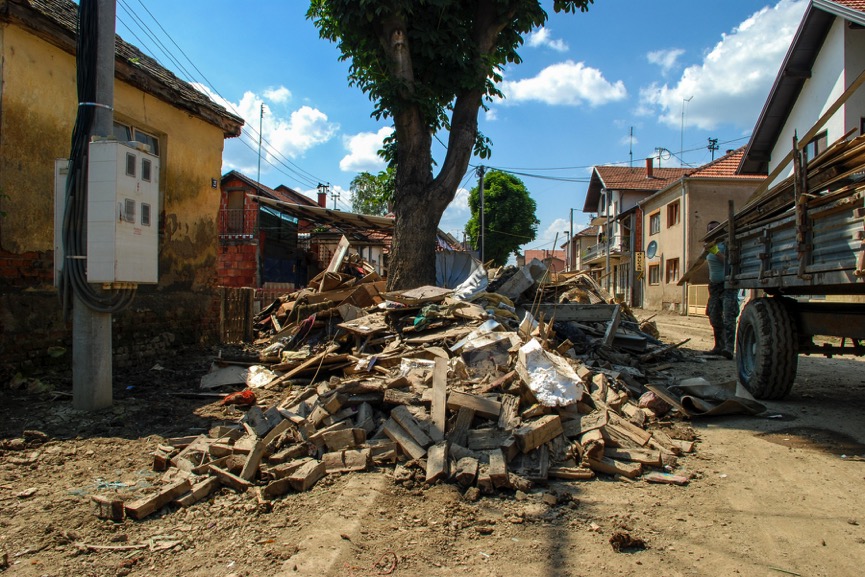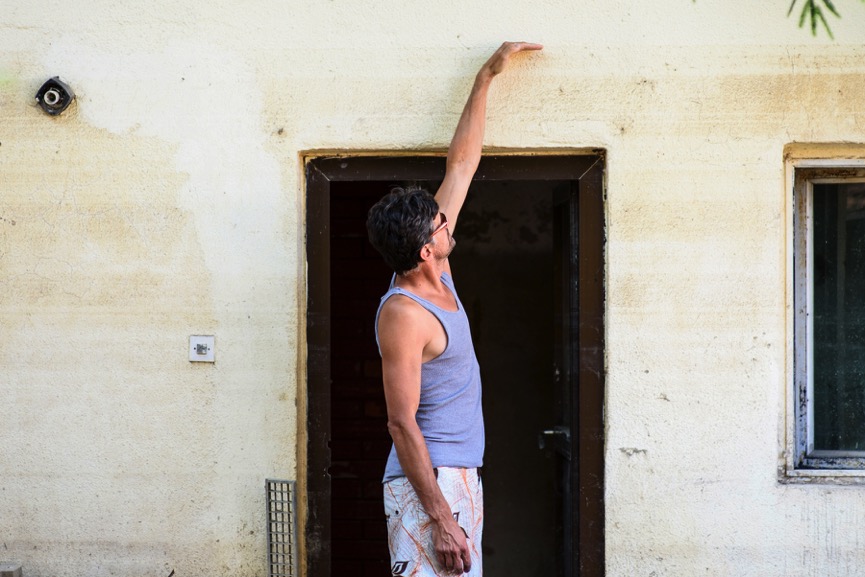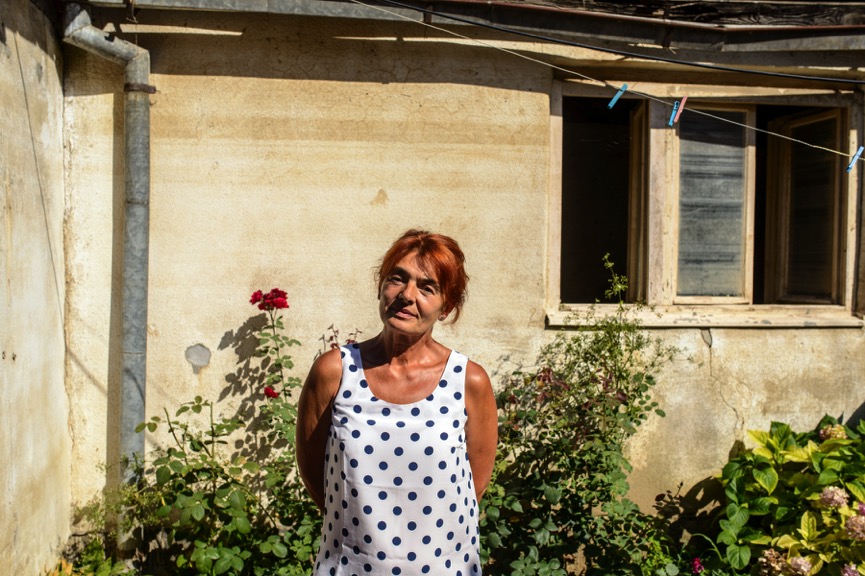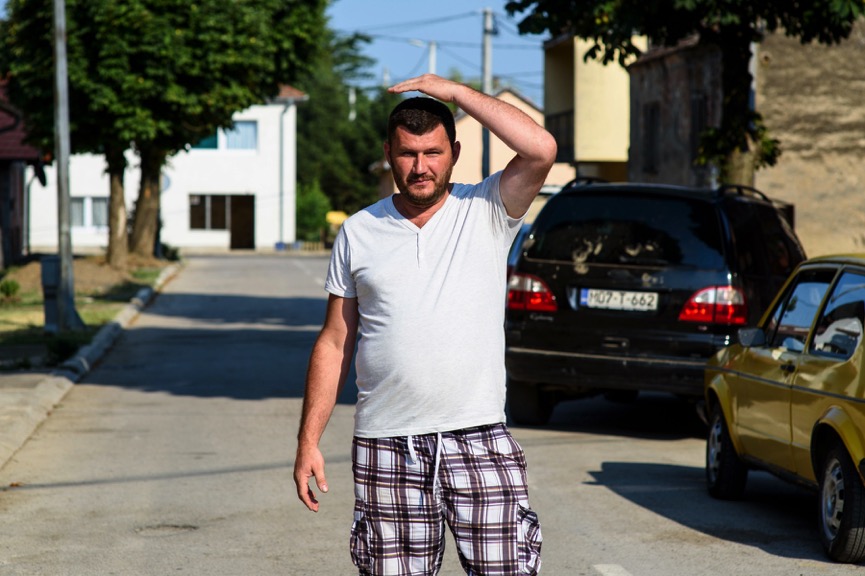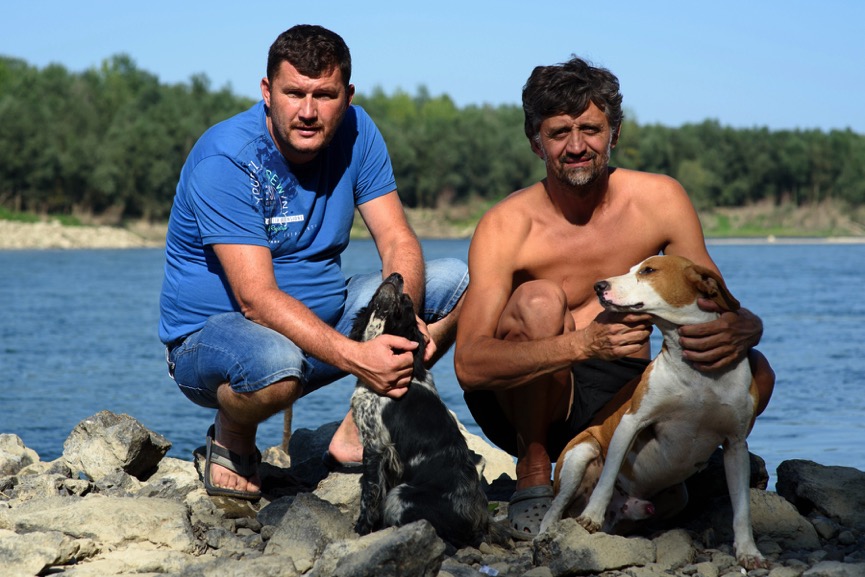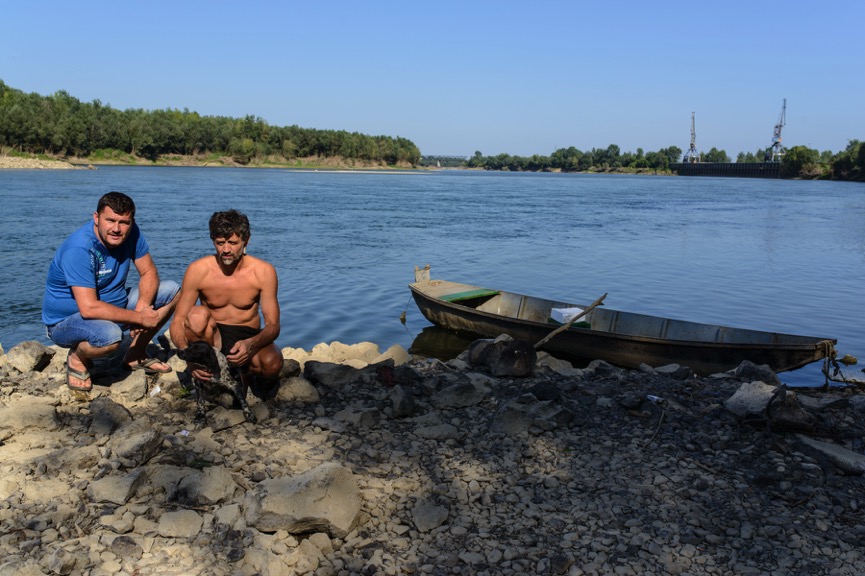How the 2014 flooding disaster affected the lives of neighbours on one street in (Bosanski) Šamac.
Photo: Jim Marshall
Where the Sava and Bosna Rivers converge, lies the town of (Bosanski) Šamac. Here the Sava separates Bosnia and Herzegovina from Croatia, and the Bosna divides Republika Srpska and the Federation of Bosnia and Herzegovina. This geographical positioning, once the town’s greatest asset, has in recent times been the source of its greatest misfortunes.
The town’s modern history has been one of construction, from the completion of the 240 km long Šamac - Sarajevo railway shortly after World War II and its establishment at that time as an industrial powerhouse, to one of destruction, not least during the 1992-95 war when numerous crimes against humanity were committed against the town’s civilian population and its industrial strength was lost. However, despite the caustic effects of ethno-nationalism and economic hardship, some sense of normality had returned to the town in recent years. Then on the 16th of May 2014, the swollen Bosna River inundated the town, causing parts of it to remain flooded for over two weeks. It is still recovering from this disaster 15 months on.
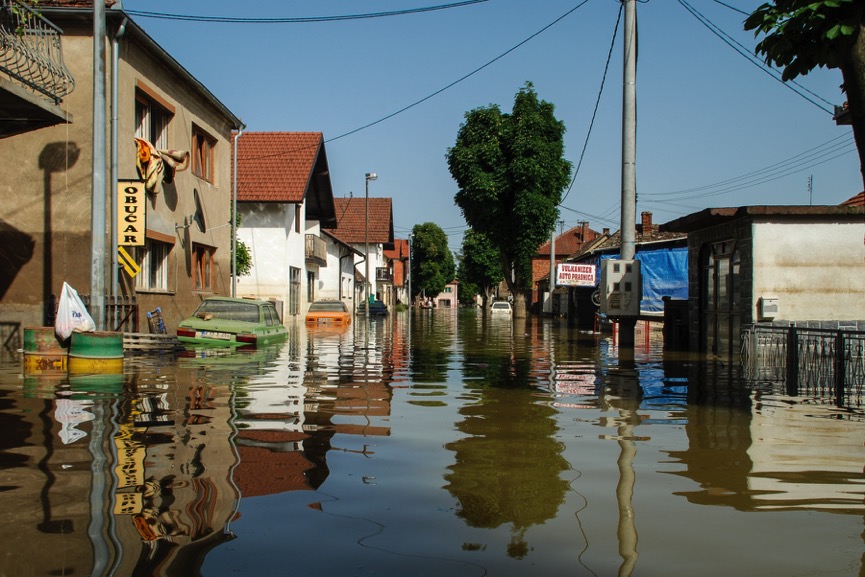
Vuk Karadžić Street on the 23rd of May 2014, a week after the flooding in Šamac began
Vuk Karadžić Street is a normally quiet street, except on schooldays when it is one of the main routes for kids heading to and from the school around the corner. Like most of the rest of the Bosanska Posavina region it is perfectly flat. It is endearingly intimate, although it can sometimes seem a little excessively so. It is home to Tošo (Teodor Pupčević), Emir (Gibić), and Ada (Adnana Tihić), who I first met during the first days of flooding when the street was accessible only to rafts.
Aid distribution on Vuk Karadžić Street, 23rd of May 2014
Were they aware on that morning in May of the risk to the town after severe flooding had already affected towns such as Maglaj two days previously, and Doboj the day before?
“Sandbags were being deployed along the Sava but I suggested to the mayor and those laying the sandbags that the threat was not from the Sava but from the Bosna, as had always been the case during flooding here,” Emir recalls. “And when I was filling my own sandbags at home people in the neighbourhood were laughing. But I was prepared, and I made sure I had a functioning boat engine, because I knew it would be devastating. As for Civil Protection, they failed, and I simply cannot believe that the man who was leading them still holds that position today.”
Emir at the entrance to his house, 23rd of May 2014
“I thought that if there was to be flooding it would not be too extensive and in the worst case scenario we could open up all the drains to release it,” Tošo echoes the thoughts of many at the time. “But it was so severe that if it had started during the night while people slept, and not during the morning as it did, there is no doubt that the risk to human lives would have been far more severe.”
Tošo (left) delivering aid in front of Ada’s house with his friend Senad, 23rd of May 2014
Ada recalls the confusion that people felt. “In a state as dysfunctional as hours, it is crucial that the media provides detailed information on matters of such significance to the public but in this case the media spectacularly failed to do so.” After her house had filled with over a metre of water in just the first two hours of flooding, a friend in the neighbouring town of Domaljevac, who at that time worked for the Presidency of Bosnia and Herzegovina, called and insisted that she and her family make it, if possible, to his house. However, within the space of a few hours, his house was also underwater. “What does it tell you when even someone who works for the Presidency was uninformed?”
Ada in front of her house, 3rd of June 2014
Tošo (left) and Emir (centre) in front of Ada’s house, 3rd of June 2014
Together with their friends Jasko and Senad from the same street, Emir and Tošo rescued hundreds during the first 24 hours of flooding using rafts and ropes, then went on to distribute humanitarian supplies throughout the town during as well as after the flooding. The first 48 hours of flooding of the town were chaotic and uncoordinated. Emergency services were present but their response was disorganized and civil protection procedures collapsed, just as it had done in other affected towns.
Ropes remain attached to a first floor balcony, 23rd of May 2014
Over the coming days outside help began to arrive, the floodwaters slowly began to recede and the rain gave way to hot weather. However, the hard work was about to begin. As May became June, what was left behind after the floodwaters receded was deep, stinking mud and debris but due to rapidly declining media and public interest there arrived only a fraction of the number of volunteers who had descended on Maglaj and Doboj.
Emir assists in the delivery of aid to a no longer flooded street, 28th of May 2014
The contents of Tošo’s house (left) and Ada’s house (right), 28th of May 2014
Vuk Karadžić Street, 28th of May 2014
Vuk Karadžić Street, 3rd of June 2014
Various forms of assistance arrived over the next few months, while other assistance was promised but never delivered, and yet more arrived too late to be of much use (in one case, over a million surgical masks arrived more than eight months after the floods).
Emir shows the highest water level, still clearly visible on the wall of Tošo’s house, July 2015
How effective has the distribution of recovery support been?
“Nobody I know is satisfied,” Ada insists. “If you compare the distribution of vouchers in R.S. to that in the Federation, yes it was definitely better organised. But why was there a need to conduct detailed damage assessments when beneficiaries were ultimately to receive precisely 5,000 km each, with no need to satisfy criteria beyond being the legal owner, and regardless of the extent of damage? And the international community’s response was a mess; it was so uncoordinated that individual organisations were constantly repeating the same process of identifying mainly the most socially vulnerable, needlessly producing nearly identical lists of potential beneficiaries.”
Ada interviewed at her home, with floodwater marks still visible on her outhouse walls, August 2015
Tošo also remains unimpressed by how recovery support has been distributed. “I applied for support that was pledged by a number of organisations including UNDP who devolved responsibility to the municipal authorities. However, I received no support since the municipal authorities lost my documentation and I had no means of proving they had my documentation as I, along with many others, received no written confirmation when I submitted my application. The municipal authorities have consistently struggled with the process of distributing assistance and have particularly failed to create and adhere to clear criteria and guidelines. Dishonest applicants have compounded the problem; for instance, people would suddenly pretend they no longer live with their wives so they can get two vouchers.”
Tošo illustrates the depth of the initial flooding of Vuk Karadžić Street, July 2015
“If you approached UNDP directly,” Tošo continues, “they would say that the municipal authorities are responsible for provision of support, and if you were to ask the municipal authorities they would insist that it is UNDP’s project. At the beginning I asked the local authorities for written criteria and they said that they know some of the criteria but not all. They insisted at that time that they were only responsible for collecting applications and that I should contact UNDP with questions related to criteria and coordination. I contacted UNDP shortly after and was informed that the municipal authorities were responsible for all aspects of the provision of support and that UNDP were only responsible for drafting the tender documentation. However, they did send me the criteria used in the tender documentation. I found out that 1,700 families had applied and it was known that 230 families were to receive help. After the list became public in November, it was obvious to me that a great number of those on the list did not match the criteria sent to me by UNDP. It was therefore not a surprise to me that this first list was annulled shortly after.”
“The Federation Government also participated in providing assistance, even in R.S.,” Ada observes. “Responsibility for providing this support was delegated to the SDA and the Islamic Community. The result was that you would walk through town and see a pile of sand in front of only Bosniak houses. Whether this was a deliberate or non-deliberate means of clearly identifying people by their ethnicity, it flew in the face of efforts and initiatives in which we have been engaged for years to improve coexistence and equality. I understood the good intentions of the Federation Government but responsibility for providing such support should not have been delegated to religious institutions or political parties. Indeed the most effective source of assistance was from volunteers who arrived out of nowhere to provide immediate assistance to us based only on our particular needs.”
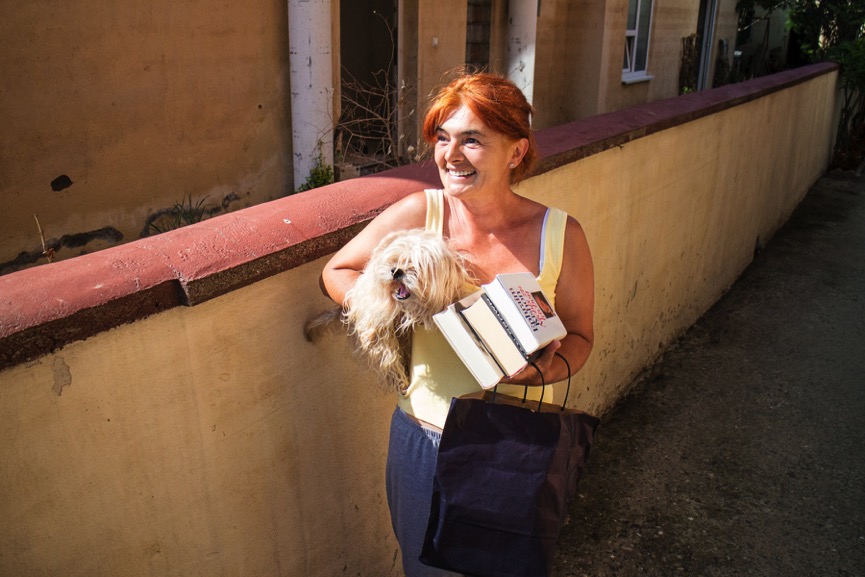
Ada receives a gift of new copies of her favourite German books that were lost in the flood, 27th of June 2014
“We don’t work on coexistence here, we live it.” Tošo elaborates. “Those who talk constantly about coexistence should just let people get on with their lives. Every time politicians interfere in dealings between ordinary people they create unnecessary divisions.”
Tošo and Emir on the bank of the Sava River, August 2015
Continuing on this theme, Tošo gives the example of a Taiwanese donor requesting a list of those who were active on rafts during the floods, to reward these individuals with a new raft in recognition of their selflessness and bravery. “Of course, we proposed the names of those most deserving. The municipal authorities participated, as did activists like Ada, and so did the chief of Civil Protection who, even though he was in Austria at the time, eagerly provided an extensive list of names, including those of many of his friends. I was eager to see if all of our team was on the list as we were active on rafts from the moment that the floodwaters inundated the town. When I discovered that Emir and Jasko in particular were missing from the list I asked why. The reply I received was basically that I should mind my own business. And although Jasko’s name thankfully appeared on the list the next day, Emir’s name never did appear and he was not even invited to join the award ceremony organised during Easter of this year. Four or five of those people who did receive this recognition played absolutely no part in assisting people during the flooding.”
In a world where climate change is producing more extreme climatic events on a far more frequent basis, have lessons been learned?
Ada’s frustration is clearly visible. “I’m afraid that where the government is concerned, I have heard no information whatsoever that there has been any systematic analysis of the events before and during the flooding to prevent future events having such a destructive and dangerous impact. I know that they started working on levies but I also know that an extensive part of the riverbank is still not secure and that we can only ask the heavens for such a disaster not to happen again.”
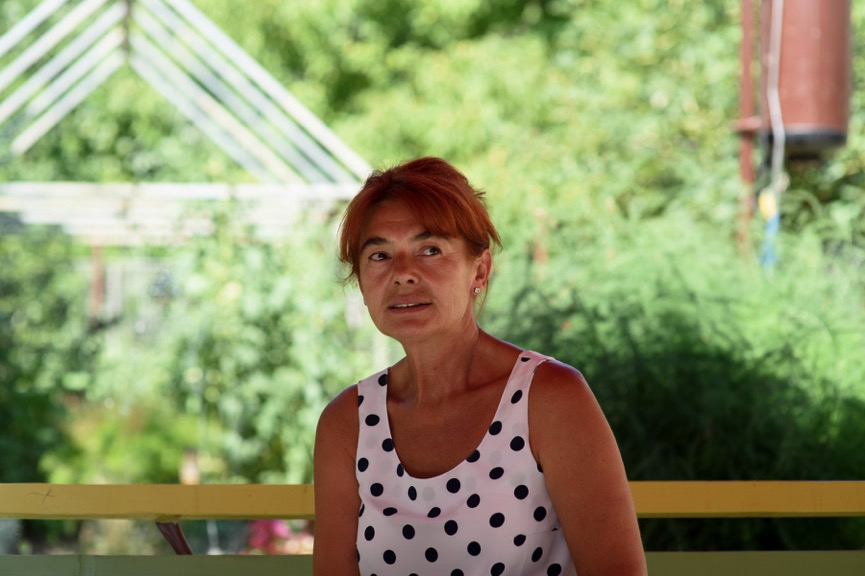
Ada interviewed at her home, August 2015
“To my knowledge there has been no analysis of the flood preparation and response in our area.” Tošo echoes Ada’s observation. “I do know that nobody ever asked any of us anything about what happened last May or what should happen in the event of future flooding.”
“The entire approach to civil protection is disgraceful.” Emir concurs. “Not a single seminar or meeting of any kind has been held since the floods to discuss future preparedness because obviously the government does not think it is important. Police and fire services in our area have little or no experience of even being on water and obviously nobody is interested in training them. I would like to see some register of who has a boat and where it is generally located in case of future emergencies. This government never even bothered to ask our team about our experiences, or to ask us for our opinions or suggestions.”
Tošo and Emir on the bank of the Sava River, August 2015
Emir’s exasperation is tangible at the end of our interview. “Nobody can really understand what it’s like when you save a man who is 100% invalid and the water is already up to his neck. I personally saved four lives and I can tell you that it’s a completely different experience to distributing food. But nobody will ever bother to talk to us about how you save lives during such an emergency. Nobody is remotely interested in learning lessons.”
This article was made as a part of the project "Investigative stories: Reconstruction after the floods in BiH". The project is implemented by Mediacentar Sarajevo and Transitions. The author of the article is responsible for the content. The stands in the article do not reflect the stands of Mediacentar Sarajevo and Transitions.
